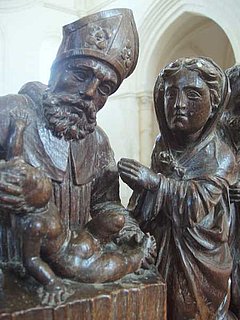Pour la loi de Moïse (cf. Lv 12,2-8), Marie, comme toute femme ayant enfanté, devait se rendre au temple pour se faire déclarer légalement pure par le prêtre : avant cela elle n’avait pas le droit d’aller dans le temple ni de toucher aux choses sacrées.
De leur propre initiative en dépassant l’obéissance à la loi
Les spécialistes ont observé qu’il n’était pas prescrit que les enfants soient aussi présentés au temple à cette occasion, et néanmoins, c’était une coutume pieuse. Ainsi, Marie et Joseph, en apportant Jésus au temple le font de leur propre initiative en dépassant l’obéissance à la loi ; ils montrent encore une fois une attitude personnelle, authentique, libre et créative, et donnent une autre signification, spirituellement plus élevée au rituel rigoureusement prescrit.
L’aspect législatif de la purification de la femme reste en arrière-fond et laisse émerger la sincérité et la force de leur foi, de l’élan du cœur dans la rencontre spontanée avec les fidèles qui convergent au temple. Leur comportement fait encore penser à l’harmonie avec soi-même, à la joie, à la dynamique de leur rapport personnel avec Dieu.
Du point de vue religieux, présenter leur enfant au temple signifie le consacrer à Dieu, reconnaître que la créature lui appartient.
Un geste aussi authentique a des significations et des répercussions affectives profondes, qui touchent le cœur des parents, qui modifient leur rapport avec le fils.
Il correspond à un pas de plus dans le développement de la conscience parentale, où le parent prend conscience que le fils ne fait pas partie de lui, n’est pas sa propriété, mais qu’il est une autre personne, avec son individualité et son destin. C’est un passage naturellement critique pour les mamans qui doivent, pour respecter l’individuation et l’autonomie des fils, accepter la rupture et la transformation du lien primitif, fait de sentiment de protection et de sécurité ; un détachement qui, comme un creuset, transforme et sublime le désir, qui a tendance à être possessif, à vouloir s’attacher, s’unir, s’appuyer, assouvir ses affections spontanées.
Ce geste ouvre au projet de Dieu sur le Fils
Ce geste ouvre au respect de la vie du fils (c’est-à-dire, dans la vision religieuse, au projet de Dieu sur lui), et appelle pour la mère une autre élaboration et spiritualisation de sa propre identité et de son propre but. A travers l’invisible fil conducteur qui guide les pas de Marie, on peut voir se dessiner le modèle du comportement de la Mère de Jésus. Les aspects religieux ne nient pas mais semblent illuminer ce qui arrive sur le plan psychologique dans le phénomène de l’engendrement.
Aussi, la maternité de Marie ne s’achève pas avec la naissance de Jésus mais elle se développe à chaque instant dans le rapport avec lui.
Mais Marie est toujours attentive à reconnaître en elle et dans la vie, dans le temple et dans la communauté sociale, l’action de Dieu.
Extraits de : Maria Rosa Filzi Curtoni, "Maria di fronte alle parole di Simeone" dans Theotokos 6 (1998), pp. 114-116. Nous remercions l’éditeur A.Valentini qui offre ces pages pour Marie de Nazareth. Extraits choisis par F. Breynaert.

